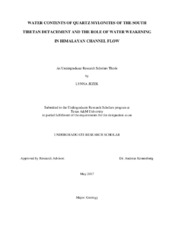| dc.description.abstract | OH absorption bands due to water in deformed quartz mylonites from the low-angle Lhotse Detachment (of the South Tibetan Detachment System, Rongbuk Valley north of Mount Everest) have been measured by Fourier Transform Infrared (FTIR) Spectroscopy. Previous work has shown that these rocks were deformed by dislocation creep at high temperatures (Law et al., 2004) and middle to lower crust (upper Amphibolite) conditions. Despite the depths from which these fault rocks come, 18O studies suggest significant influx of meteoric water is synchronous with mylonitic deformation and exhumation of the region (Gébelin et al., 2013). OH absorption bands at ~3400 cm-1 of quartz mylonites from the footwall of the Lhotse Detachment fault are large, with the character of the molecular water band due to fluid inclusions in milky quartz. Mean water contents depend on structural position relative to the core of the Lhotse Detachment, from ~1000 ppm (OH/106 Si) at 420 m below the fault to 11,350 (± 1095) ppm near its center. This gradient implies influx of meteoric water along the Lhotse Detachment from the Tibetan surface to mid-crustal depths and significant fluid penetration into the extruding Himalayan slab by intergranular, permeable fluid flow processes. Increased water contents of quartz may also be responsible for continued deformation and strain localization on the South Tibetan Detachment System.
Dislocation creep in quartz is facilitated by water in laboratory experiments, and the water contents of the Lhotse fault rocks are similar to water contents of synthetic hydrated quartz. Penetration of meteoric fluids to mid-crustal depths could help explain why Lhotse rocks have much higher intragranular water content than quartz mylonites of the Main Central Thrust (with OH contents of just 170 ppm) deformed at greater crustal depths in the Himalayan slab below the South Tibetan Detachment System. Existing knowledge of water weakening in quartz has been mainly derived from laboratory experiments, and this study will examine its importance in nature. | en |


